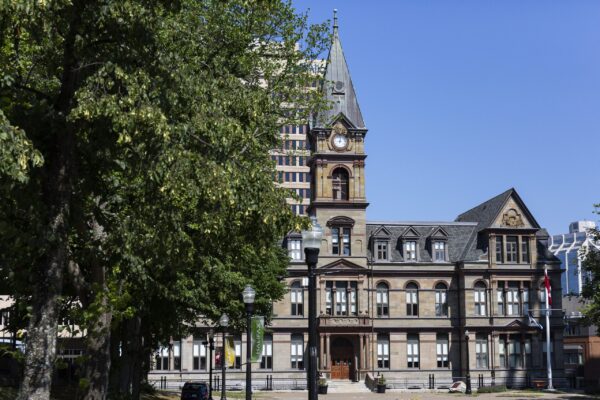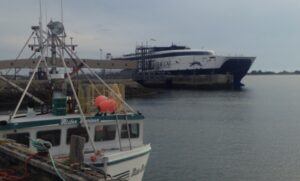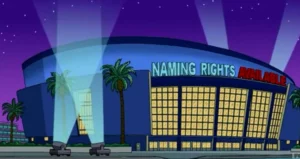What’s in a name? Money, that’s what
News
1. Woodford Report: this week at Halifax council

Halifax City Hall in August 2020. — Photo: Zane Woodford
Halifax councillors spoke of many things at Tuesday’s meeting, and Zane Woodford brings you his usual roundup.
Councillors voted to direct staff to develop amendments to legalize “market gardens” — where food is “grown or prepared to be sold or shared with neighbours and community members.”
Also, councillors officially approved a staff recommendation to let Emera retain naming rights for the skating oval on the Halifax Common.

A skater at the Halifax skating oval in February 2020. — Photo: Zane Woodford
I’ll tell you what could help cover that unknown cost, though. Nova Scotia Power could soon be approved to raise rates 11.6% over the next three years. The Emera subsidiary is entering day three of hearings before the Nova Scotia Utility and Review Board (UARB). The company says it needs to raise rates on Nova Scotians money for a number of reasons: rising fuel costs, endless delays getting power from Muskrat Falls, the price of making (or failing to make) the grid greener as we look to get off coal. Add paying-to-put-our-name-on-a-skating-oval to the list of reasons Nova Scotia Power should get more of your money, I guess.
I’m getting off topic here, though.
Head to Woodford’s full summary of news from Tuesday’s Halifax council meeting.
This article is for subscribers only. You can subscribe here.
2. Yarmouth Chamber of Commerce responds to premier’s ferry criticism

The Alakai, docked at Yarmouth in 2019. Photo: Suzanne Rent
This weekend, Stephen Kimber wrote about Tim Houston’s disappointment with the Yarmouth ferry, the CAT. If you didn’t catch what Houston said publicly, here’s a transcript:
I certainly am absolutely disappointed with the numbers. Nova Scotians have invested a significant amount in an operation over the last number of years and I think every Nova Scotian should be disappointed with the uptake on the service… I think everyone has always been hopeful that things will turn around. I haven’t seen that yet, but we’ll let the season finish out. We’ll look at the final numbers and make some decisions based on that.
Kimber agreed that Houston had a right to be disappointed, then went on to write a very helpful, clarifying summary of the decisions and events from the last decade or so that have made the ferry between Yarmouth and Maine such a costly failure for this province. From the NDP’s decision to cancel the province’s subsidy for the ferry in 2009, to Stephen McNeil’s Liberals and their decision to sign a 10-year contract with different ferry operators that took on too much risk for the province and too little for Bay Ferries.
Then there was the decision to move the Maine destination from Portland to Bar Harbor before the terminal was ready, effectively cancelling the 2019 season before COVID ruined another two summers.
Anyway, Michael Gorman at the CBC has a story with some response to the premier’s comments, specifically from Rick Allwright, the executive director of the Yarmouth Chamber of Commerce. Allwright is asking Houston and his government to stop criticizing the ferry and instead undertake an economic analysis of the service.
“We need to make sure that this link stays and it keeps our whole tourism sector viable,” Allwright said.
Gorman reports that local businesses have seen some benefit from the close to 40,000 people who’ve used the ferry this summer, and the Chamber of Commerce feels things are only going up.
Here’s hoping.
But Premier Houston’s comments, based on the history of failure that is the Yarmouth ferry, seem refreshingly honest, if pessimistic.
3. Province gets one-time holiday for queen’s funeral

Photo: unsplash/Tomas Martinez
The funeral for Queen Elizabeth II is Monday, and yesterday Nova Scotia government announced it will be a one-time provincial holiday. Or as Tim Bousquet called it on Twitter yesterday, “The Elizabeth Alexandra Mary Windsor Memorial kegger.”
Following the Prime Minister’s lead — September 19 will also be a federal holiday — the province announced Tuesday that government offices, public schools, and regulated child care will be closed.
Businesses will have the choice to remain open.
It won’t be a holiday everywhere in Canada. While all four Atlantic provinces will observe it, Quebec (obviously), Ontario, Manitoba, and Saskatchewan won’t have a stat holiday Monday.
Not everyone will be happy about the holiday. The Canadian Federation of Independent Businesses said in a release it thinks a short notice holiday punishes businesses, for example. But I’m talking more about how people feel about the monarchy.
Anti-monarch protestors have been arrested in the UK in the past week, which raises questions of free speech that are as curious as they are concerning. I think there’s been some excessive backlash to Elizabeth’s reign in the wake of her death, but it’s reasonable to have some problems with the Crown.
I’ve written in previous Morning Files about my distaste, or at least lack of interest, for the British monarchy and its role in modern Canadian society. It’s inherently classist, imperialist, and colonialist, and full of rigid and nonsensical pomp. It no longer has any real political power, serving only as a reminder of an outdated, oppressive way of governing. It’s been mired in scandal, which led Elizabeth’s grandson to leave the royal family, and forced her own son out of it.
If it were up to me, the monarchy would end here, with the queen’s death. But it’s not, and people love this stuff for some reason, so on it goes.
Here at home, it feels a little strange to make Monday a holiday honouring a monarch whose line helped colonize this land, when we have another holiday honouring reconciliation at the end of the month. But hey, who doesn’t like a long weekend.
I will say this. While I think her role was ridiculous and contrary to the values of 21st century western society, I respect the way Elizabeth carried herself throughout her career. Whatever you think of the inherently flawed institution that she perpetuated, you’ve got to admit she did about as good a job as anyone could’ve expected. Not many people could have given up their life for the Crown the way she did. I don’t think anyone should be asked to again.
4. Rain on the Rock

Photo: Twitter/VOCM
In Newfoundland, post-tropical storm Earl has battered the Avalon peninsula with 200 millimetres of rain over the past couple days. Pictures of cars in St. John’s driving through flooded city roads have been all over social media. According to VOCM, Newfoundland’s Voice of the Common Man, the full extent of the damage is still being assessed, but four roads in St. John’s remain closed in the wake of the storm.
Flooding there is concerning, of course, but there’s a far more interesting flood-related story from that province making headlines this week.
In Labrador, residents of the small town of Mud Lake are being offered up to $270,000 to abandon their homes and move out of the community. After flooding destroyed properties and forced evacuations there in 2017, the province fears similar natural disasters could repeat in the future, and is therefore offering cash incentives for residents to move.
The CBC reported Friday that the province normally requires three-quarters of a community to vote for relocation before the government will assist, but the “environmental circumstances and geographic location of the community” have led them to act more urgently.
It wouldn’t take many relocations to alter the face of the community. The 2021 census lists only 54 residents in Mud Lake, which is only accessible by boat. On Monday, the CBC published another article, written by Andrew Hawthorn, getting reaction from residents about the proposal to move. Hawthorn reported that about five people had already moved since the offer was made, but local man Watson Rumbolt, who spoke with Hawthorn, doesn’t think there’ll be many more takers.
“It’s a job to say, ‘Oh, I’m going to leave everything behind me for $250,000,” he told CBC. “As long as I got my family around me, I mean, I’m not going anywhere.”
Despite his resolve to stay, Rumbolt says he still fears repeat flooding.
What’s most interesting here, though, is why he fears it. We hear all the time about how we might lose communities forever as a changing climate make s certain regions uninhabitable for the long-term. That seems like a possibility in Mud Lake. An independent review of the 2017 flood found unusually heavy rains and ice blockages caused flooding that year, but residents disagree.
They believe the Muskrat Falls hydro-dam is to blame. And residents are currently embroiled in a class action lawsuit against Nalcor Energy, the Crown corporation in charge of the project, seeking compensation for the disaster.
In 2018, John Gaudi and Bailey White wrote a thorough, compelling article on the flood for the CBC. If you have a little time for some long-form journalism this morning, it’s worth checking out.
In the article, the two reporters speak with residents of Mud Lake about the flooding. One, Melissa Best, told them she didn’t have proof Nalcor and Muskrat Falls were responsible, but said the ice in the Churchill River was significantly thicker after Nalcor Energy repaired a leak in its cofferdam in the winter of 2017. From the article:
The leak forced the company to release water from the reservoir into the river. After it froze, Best said, ice was four or five feet thicker than it normally is.
“It took us from a very comfortable, safe community and put us in harm’s way, and it was that morning of May 17 that we realized that even this beautiful picturesque community tucked away that was safe for hundreds of years is no longer safe,” she said.
Best doesn’t trust Nalcor Energy or the provincial government. Despite Premier Dwight Ball visiting the community less than a week after the flood occurred — before most people had even returned home — she feels the province hasn’t acknowledged what the community went through.
Now, Halifax lawyer Ray Wagner, who is representing Mud Lake in the lawsuit, told CBC this week he sees the relocation offer as that acknowledgement. Though, he said he’s upset there was little communication with residents before the resettlement offer, and there’s nothing to suggest the province or Nalcor are taking responsibility for the 2017 flood.
“I’m happy to hear that they’re going to do the right thing,” said Wagner.
Rumbolt, for his part, is more cynical about the offer.
“I think that they’re offering us this … to try to get everybody to move, so that way if something happens they don’t have to deal with Mud Lake no more.”
All this begs the question: is there a single positive story surrounding the Muskrat Falls hydro-dam?
Views
What’s in a name? Money, that’s what

Photo: Simpsons wikipedia
It took a few hundred years, but our corporate western society would eventually answer Shakespeare’s famous question: What’s in a name? The answer? Money.
It’s nothing new by this point to see buildings, stadiums, and public places named after businesses, banks, and even websites that have spent millions to turn the places we frequent into huge billboards.
Across Canada, the dream now seems to be getting two cars in every garage and one Scotiabank Centre in every town. Thankfully, most people still call it the Metro Centre, but it still hurts to see that big red ad plastered on the cement by Citadel Hill. And I don’t even think the (former) Metro Centre was all that great a facility to begin with.
Now that Halifax regional council has voted to keep Halifax’s skating oval, one of the city’s most popular public spots, named after one of the province’s most hated entities, I thought I’d write a few thoughts on naming rights.
First off, I don’t necessarily have a problem with them. When it comes to the oval, the money that comes in from selling the name does some good. It helps fund the facility and the equipment that gets lent out for free to the public. However, the oval is such an integral public space, used by so many in Halifax and beyond, there’s something dirty about an energy company logo being attached to it.
Why is that?
When I think of Wrigley Field, I don’t think about chewing gum. I think about the most beautiful baseball field ever constructed. The stadium itself is untainted by the name it holds, for me anyway.
But then there are more unfortunately named stadiums.
Enron Field in Houston, for example. The Houston Astros had to pay $2.1 million for the right to rename their field after that now-defunct company was investigated by a Senate committee for its business practices. While Emera has had no such scandal, the relationship between Nova Scotians and the company makes it a bit distasteful to see its name associated with such a cherished piece of public infrastructure.
Much like the controversy surrounding parks, schools, and streets named after historical figures with questionable pasts — see Prince Andrew, Edward Cornwallis, and so on — selling the name of a building the public uses to a corporation runs the risk of biting you later, even if it puts a few million in your pocket.
At least “Enron Field” sounds okay.
Other corporate names don’t have much of a ring to them. Take the old jobing.com Arena where the NHL’s Coyotes used to play. Or the bizarrely named Save-on-Foods Memorial Centre in British Columbia. Did Save-on-Foods die? Or did they name the stadium as a tribute to fallen soldiers and then let a grocery store attach an ad to the title? Not great either way.
The university formerly known as Ryerson had the chance, in theory, to make a buck from their name change when they dissociated from their controversial namesake. But Toronto Metropolitan University had a better, what-it-says-on-the-tin feel than, say Amazon Prime Institute of Higher Learning.
As our society has become more privatized and corporate, naming rights have become a popular target for attack.
In Infinite Jest, David Foster Wallace envisioned a future in which we abandoned numbered years and instead named our annual calendar after Depends Adult Diapers and other high-bidding corporate entities. In Mike Judge’s highly under-rated Idiocracy, the United States Congress became sponsored by a Gatorade knockoff and the future president changed his middle name to Mountain Dew for a little extra cash.
We can easily agree those scenarios are ridiculous.
I’d argue continuing to name the Halifax Oval after a company that’s trying to squeeze Nova Scotians in a time of growing financial difficulty, while failing to meet the environmental changes it’s been charged with, is equally ridiculous.
If you own private property, and you want to sell the name of it to the highest bidder, that’s your prerogative. But public spaces shouldn’t become ads. The name, like the space itself, should be for the public.
I’ll gladly fundraise and pay $5 each time I rent skates if that’s the alternative.
Noticed
Shoot for the stars

Canadian restaurants have received Michelin stars for the first time ever this week. Photo: Michelin North America Inc.
Hey hey, Canada’s on the map!
Michelin Stars have been awarded to restaurants in this country for the first time. And by some unbelievable stroke of luck, all 74 of those restaurants are in Toronto. I guess it’s true what they say, Toronto really is the centre of the universe.
Michelin Stars, I’m sure you know, are highly sought after awards for chefs and restauranteurs. But I’m sure some of you are still a little unsure about how a tire company became so prominent in the food scene.
The annual Michelin Guide, which awards the stars, was created with the loftiest of culinary goals in mind: to sell tires. In 1900, the Michelin brothers figured they could get more people driving cars, and therefore buying tires, if they promoted destinations worth driving to. And so, from those noble beginnings, that grand tradition of gastronomical excellence and prestige has continued to this very day, where it has finally arrived in Canada 122 years later.
There’s been a lot of excitement and buzz in Toronto leading up to the announcement. There’s also been some backlash.
That’s because the Michelin Guide has come under scrutiny in recent years. From accusations that the guide is partial to certain types of cuisine, a shady reviewing process — reviewers apparently don’t visit every restaurant they award stars to each year — and the harsh working conditions and effects on mental health that come from the chase for the prestigious rating system’s acknowledgement of your restaurant, not everyone thinks we should care that Canada, or Toronto rather, now has some businesses recognized by a French tyre company.
Canada, and Toronto, have long been like an awkward teenager, desperate for outside validation. Never content to be happy with itself. This latest restaurant buzz really exemplifies that mode of thinking.
Back in May, Toronto restauranteur and author Jen Agg contributed an opinion piece to the Globe and Mail, in which she derided the city’s fawning and anticipation of the guide’s consideration of her hometown. I thought I’d share a bit of it in light of the new Canadian Guide.
She starts with some basic criticisms from around the world, along with some of the positives that make the stars so a desirable:
Michelin has been subject to a mounting chorus of criticism in recent years. Some of the newly published guides, including in Asia and South America, have been revealed to have been at least partly funded by local tourism boards.
Others have criticized Michelin as being Eurocentric and elitist. Historically, the guide has been focused on European fine dining: on white tablecloths, sparkling silverware and carefully curated wine lists. As such, many have questioned the relevance of a Michelin guide in Canada, given the relatively casual nature of our dining culture, and the extraordinary diversity offered by our cuisines.
Others too have questioned the timing of the announcement given the challenges facing restaurant workers amidst the pandemic, and notoriously poor working conditions in the industry. More than 800,000 food-service workers either lost their jobs or saw their hours cut in the first few months of the pandemic, according to Restaurants Canada. Nearly a year later, less than half of those jobs had been restored.
Still, the news comes at an opportune time for restaurant owners. The vast majority of restaurants – at least 86 per cent, according to Restaurants Canada – saw their revenue drop at the outset of the pandemic. And while casual restaurants were able to pivot to takeout and delivery, fine dining struggled.
For those restaurants, a Michelin star might help speed up the recovery. A 2018 study in the Stanford Economics Review found that, historically, a one-star Michelin rating at restaurants translated into a 15-per-cent price premium for restaurants.
“In addition,” the study noted, “earning a Michelin star is almost always accompanied by a significant boost in business.”
From there, Agg gets into the most interesting part of her piece. Why should Toronto, or Canada for that matter, care about what the world thinks of our ability to produce world-class culture? What will the star system do to our restaurant scene and its workers?
Despite the Toronto Raptors winning it all in 2019 – finally, we are a world-class city! – we still love, maybe even prefer, our praise from outside sources.
So when the food world’s version of the NBA Finals finally arrived in Toronto this month – Michelin (yes, the tire company) – the thirst was real.
So what does this attitude mean for the people actually working in these “thirsty” restaurants?
There is a deep camaraderie in restaurants that makes them addicting workplaces. But if you were to work in one that tries to win “best of” lists like Michelin, too often you’d find a toxic culture — places where they focus on hospitality and being a “house of yes” to the diners, yet say no to reasonable requests from employees, such as asking that they not be sexually harassed on the job, or wanting to, y’know, be paid for all their hours worked. Of course, Michelin doesn’t pay attention to all that — if they did, a lot of places would be disqualified. Winning and retaining those Michelin stars comes with huge pressure, too; two chefs died by suicide just before the annual Michelin announcements in France, and it is widely believed that the deaths were at least in part because their restaurants were at risk of losing a star.
So Michelin stars are somehow still a thing, even though food trends have changed so dramatically that the guides’ narrow vision of luxury fine dining standards seems like it belongs to a bygone age. (It used to be that we’d have to wait for Thomas Keller to drop another overpriced tome of recipes to try and lift his moves; now, we’re in a hall of mirrors, looking at each other through Instagram or TikTok.) And in fact, the program is relatively unwilling to actually be more inclusive to great restaurants that don’t fit that definition, though things are a little better in the Asia guides.
While it’s ostensibly meant to award the most exciting chefs – the ones who are thinking outside the box – Michelin seems more about conformity to a homogeneous kind of luxury experience. You can feel when a restaurant is going for Michelin stars by the way they plate food, or from the proliferation of ingredients such as caviar (a perfect food) or Wagyu beef (which I would happily never eat again). If there’s a bit of edible gold leaf on your dessert – which is of course a very dumb thing – you can be assured it is because the kitchen is shooting for that star.
Toronto has been thirsty for Michelin for years, and Michelin insists that it’s arrived thanks to the city’s “impressive culinary landscape.” And yes, it is a great eating town – but it has been for more than a decade. So what’s changed? Perhaps money from restaurant and tourism groups: According to Andrew Festa, who is in charge of PR for Michelin North America, “Destination marketing organizations cover some of the costs incurred in establishing the Michelin Guide in a new location.” The word “some” feels like it’s doing a lot of heavy lifting here.
If you haven’t been able to tell from my recent diatribe against the Junos, you should see now how ridiculous I find the whole idea of awards. The search for external praise or validation so often becomes a higher priority than producing quality work in whatever field it is you’re awarding.
And it irks me when I see Canada and its cities so hungry for recognition outside this country. A movie star or singer hasn’t made it unless they move to the US. Now a Toronto restaurant isn’t worthwhile unless Michelin has recognized it. It’s the same thing. And while Michelin stars might not mean much to you when choosing a restaurant, the allure of the award and the attitude around it are real. And there are costs associated with it. Even for people like Agg, who’d like to think they’re above shiny, meaningless merits.
Of course, I have zero expectations that one of my restaurants will be offered a Michelin star, though I have said repeatedly that I would return it, if one won. But I think that might be incredibly selfish. Having spoken to chefs who work for me, of course I realize how much Michelin means to them; there is simply no bigger reward they can achieve in their field, one that demands so much of their time and energy. It would mean so much to the cooks and servers working in the restaurants every night — plus, I don’t think it would be a particularly wise long-term business decision, either. I have spent my career both participating in and pointedly criticizing the restaurant industry, which has earned me few friends within its walls — a price I happily pay. It’s obvious that if you want a certain kind of coverage or award, you need to play a certain kind of game that I’m unable and unwilling to play. But what does that mean for the people associated with me as partners and chefs? Do they suffer unfairly because of my battle-ready spirit?
We are so hard on ourselves in Toronto’s restaurant scene, to the point that we too often end up chasing homegrown talent out. Maybe being a Michelin town will give Toronto that last bit of world-class-city anointment we need to finally feel like we are good enough and that people actually like us. But that really shouldn’t be the thing, should it? After all, it’s like Anthony Bourdain told Canadians, in a 2016 interview with Maclean’s: “I think you’re doing it right if Michelin hasn’t come … you don’t owe them nothing.”
I’m not even a foodie. I could eat salted fish with rice and a salad for dinner every day for the rest of my life. But I just find this fascinating.
Government
City
Wednesday
Transportation Standing Committee (Wednesday, 10am, online) — special meeting
District Boundary Resident Review Panel (Wednesday, 3:30pm, City Hall) — agenda
Western Common Advisory Committee (Wednesday, 6:30pm, online) — agenda
Thursday
Community Planning and Economic Development Standing Committee (Thursday, 10am, City Hall) — agenda
Active Transportation Advisory Committee (Thursday, 4:30pm, online) — agenda
Youth Advisory Committee (Thursday, 5pm, Power House Youth Centre) — agenda
Public Information Meeting – Case 24017 (Thursday, 6pm, Sackville Heights Community Centre) — info here
Province
No meetings
On campus
Dalhousie
Wednesday
No events
Thursday
Decoding the molecular mechanism of solid aggregate clearance (Thursday, 11am, online) — Liang Ge, from Tsinghua University, Beijing, China, will talk
In the harbour
Halifax
06:00: X-press Irazu, container ship, arrives at Pier 41 from Lisbon, Portugal
09:30: Celebrity Summit, cruise ship with up to 2,100 passengers, arrives at Pier 22 from Saint John, on a 10-day roundtrip cruise out of Boston
09:30: Seven Seas Navigator, cruise ship with up to 550 passengers, arrives at Pier 20 from Saint John, on an 11-day cruise from New York to Montreal
10:30: Contship Leo, container ship, sails from Pier 42 for sea
10:30: One Houston, container ship, sails from Fairview Cove for Dubai
11:00: Oceanex Sanderling, ro-ro container, arrives at Pier 36 from St. John’s
12:30: Seaborne Quest, cruise ship with up to 540 passengers, arrives at Pier 23 from Bar Harbor, on a 12-day cruise from New York to Montreal
12:30: East Coast, oil tanker, arrives at Irving Oil from Saint John
16:00: John J. Carrick, barge, and Leo A. McArthur, tug, sail from Cherubini for sea
16:00: Gotland, cargo ship, sails from Pier 27 for sea
16:30: X-press Irazu sails for sea
17:00: Majestic, superyacht owned by Miami Marlins owner Bruce Sherman, arrives at berth TBD from Montreal
18:00: Celebrity Summit sails for Charlottetown
18:30: Seven Seas Navigator sails for Sydney
20:00: Maccao, bulker, arrives at berth TBD from Qinhuangdao, China
Cape Breton
06:00: Carnival Magic, cruise ship with up to 4,428 passengers, arrives at Sydney Marine Terminals from Saint John, on a seven-day roundtrip cruise out of New York
06:15: Arcadia, cruise ship with up to 1,904 passengers, arrives at Liberty Pier from Corner Brook, on a 30-day roundtrip cruise out of Southampton, England
16:30: Phoenix Admiral, oil tanker, arrives at EverWind (Point Tupper) from New York
17:00: Carnival Magic sails for Halifax
18:00: Arcadia sails for Halifax
Footnotes
- I once worked for Michelin. Not in the star-awarding department though. It was a student internship in document processing. They paid me minimum wage to shred documents, sort the basement archive files, and mostly just pass the time reading books. I only learned two things from that job: desk work isn’t for me, and the Michelin Man’s real name is Bibendum.
- Have you ever read Infinite Jest? I’ve made it through the first 200 pages twice, but never completed it. If you’re like me, check out this hilarious New Yorker piece written by Claire Friedman in 2018: a step-by-step guide to reading David Foster Wallace’s brick of a book. It won’t actually help you get through it, but it will make you care less that you still haven’t gotten around to it. It’ll also make you laugh, and unlike Infinite Jest, you can finish it in one short sitting.
- I haven’t been to the post office or my local Legion recently; have they put up a picture of King Charles III yet?
- “Highness” is such a stupid word.
- ICYMI: Major League Baseball is bringing a number of rule changes to next year’s season. Since you likely don’t care, I won’t write anything more about them. Happy Wednesday.
Subscribe to the Halifax Examiner
We have many other subscription options available, or drop us a donation. Thanks!



